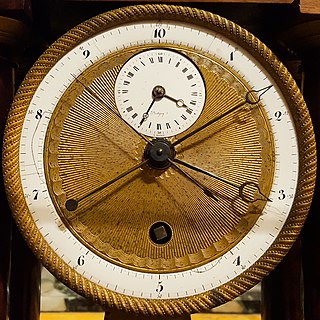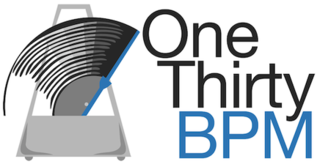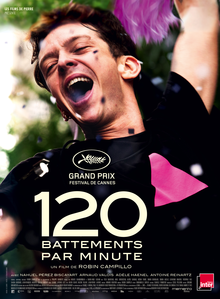
Frequency is the number of occurrences of a repeating event per unit of time. It is also occasionally referred to as temporal frequency for clarity and to distinguish it from spatial frequency. Frequency is measured in hertz (Hz) which is equal to one event per second. Ordinary frequency is related to angular frequency by a scaling factor of 2π. The period is the interval of time between events, so the period is the reciprocal of the frequency.

The hertz is the unit of frequency in the International System of Units (SI), equivalent to one event per second. The hertz is an SI derived unit whose expression in terms of SI base units is s−1, meaning that one hertz is the reciprocal of one second. It is named after Heinrich Rudolf Hertz (1857–1894), the first person to provide conclusive proof of the existence of electromagnetic waves. Hertz are commonly expressed in multiples: kilohertz (kHz), megahertz (MHz), gigahertz (GHz), terahertz (THz).
Rhythm generally means a "movement marked by the regulated succession of strong and weak elements, or of opposite or different conditions". This general meaning of regular recurrence or pattern in time can apply to a wide variety of cyclical natural phenomena having a periodicity or frequency of anything from microseconds to several seconds ; to several minutes or hours, or, at the most extreme, even over many years.
In musical terminology, tempo is the speed or pace of a given piece. In classical music, tempo is typically indicated with an instruction at the start of a piece and is usually measured in beats per minute. In modern classical compositions, a "metronome mark" in beats per minute may supplement or replace the normal tempo marking, while in modern genres like electronic dance music, tempo will typically simply be stated in BPM.
In mathematics, a rate is the ratio between two related quantities in different units. If the denominator of the ratio is expressed as a single unit of one of these quantities, and if it is assumed that this quantity can be changed systematically, then the numerator of the ratio expresses the corresponding rate of change in the other (dependent) variable.
In music theory, the pulse is a series of uniformly spaced beats—either audible or implied that sets the tempo and is the scaffolding for the rhythm. By contrast, rhythm is always audible and can depart from the pulse. So while the rhythm may become too difficult for an untrained listener to fully match, nearly any listener instinctively matches the pulse by simply tapping uniformly, despite rhythmic variations in timing of sounds atop the pulse.
A nonstress test (NST) is a screening test used in pregnancy to assess fetal status by means of the fetal heart rate and its responsiveness. A cardiotocograph is used to monitor the fetal heart rate and presence or absence of uterine contractions. The test is typically termed "reactive" or "nonreactive".

Decimal time is the representation of the time of day using units which are decimally related. This term is often used specifically to refer to the time system used in France from 1794 to 1800, during the French Revolution, which divided the day into 10 decimal hours, each decimal hour into 100 decimal minutes and each decimal minute into 100 decimal seconds, as opposed to the more familiar UTC time standard, which divides the day into 24 hours, each hour into 60 minutes and each minute into 60 seconds.

A march, as a musical genre, is a piece of music with a strong regular rhythm which in origin was expressly written for marching to and most frequently performed by a military band. In mood, marches range from the moving death march in Wagner's Götterdämmerung to the brisk military marches of John Philip Sousa and the martial hymns of the late 19th century. Examples of the varied use of the march can be found in Beethoven's Eroica Symphony, in the Marches Militaires of Franz Schubert, in the Marche funèbre in Chopin's Sonata in B flat minor, the "Jäger March" in the Op. 91a by Jean Sibelius, and in the Dead March in Handel's Saul.

Pasodoble is a fast-paced Spanish military march used by infantry troops. Its speed allowed troops to give 120 steps per minute. This military march gave rise recently to a modern Spanish dance, a musical genre including both voice and instruments, and a genre of instrumental music often played during bullfight. Both the dance and the non martial compositions are also called pasodoble.
Revolutions per minute is a unit of frequency, commonly used to measure rotational speed.

Multifocal atrial tachycardia (MAT) is an abnormal heart rhythm, specifically a type of supraventricular tachycardia, that is particularly common in older people and is associated with exacerbations of chronic obstructive pulmonary disease (COPD). Normally, the heart rate is controlled by a cluster of cells called the sinoatrial node. When a number of different clusters of cells outside the SA node take over control of the heart rate, and the rate exceeds 100 beats per minute, this is called multifocal atrial tachycardia.
The inverse second or reciprocal second (s−1), also called per second, is a unit of frequency, defined as the multiplicative inverse of the second. It is dimensionally equivalent to:

Beats Per Minute is a New York City– and Los Angeles–based online publication providing reviews, news, media, interviews and feature articles about the music world. Beats Per Minute covers a variety of genres and specializes in rock, hip hop, and electronic music.
Pressure rate product, within medical cardiology, specifically for cardiovascular physiology and exercise physiology is used to determine the myocardial workload.

BPM (Beats per Minute), also known as 120 BPM (Beats per Minute), (French: 120 battements par minute) is a 2017 French drama film directed by Robin Campillo and starring Nahuel Pérez Biscayart, Arnaud Valois and Adèle Haenel. The film is about the AIDS activism of ACT UP Paris in 1990s France. Campillo and co-screenwriter Philippe Mangeot drew on their personal experiences with ACT UP in developing the story.

From tha Streets 2 tha Suites is the eighteenth studio album by American rapper Snoop Dogg. It was released on April 20, 2021 through Doggy Style Records. The album was released to celebrate 420. Production was handled by Amplified, DJ Battlecat, DJ Camper, Nottz, ProHoeZak, Rick Rock, Soopafly, Terrace Martin and The Mekanix. It features guest appearances from J-Black, ProHoeZak, Devin the Dude, Kokane, Larry June, Mozzy and Tha Eastsidaz.

The Course of the Inevitable is the fourth studio album by American rapper Lloyd Banks. It was released on June 4, 2021. It is his first full-length studio album since H.F.M. 2 (2010), and his first to be released since his departure from G-Unit Records in 2018.









